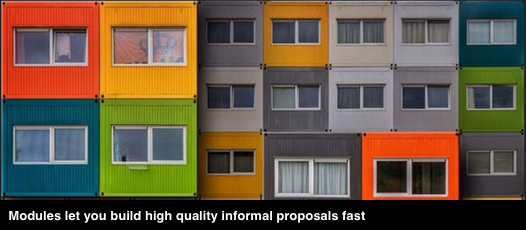A recent post identified ideal situations for informal proposals and argued for pre-building content to enable fast responses without sacrificing quality. This week and next we’ll show you how to approach pre-building content.
The payoff for following this model can be huge. Using prebuilt sections, one of our clients now spends just two or three hours to create proposals that used to take 15 hours or more. They now submit proposals within a few days instead of a few weeks—and the proposals themselves are winning more business.
Brainstorm the modules you’ll need
Start by considering the types of questions your proposal needs to answer. One way to do this is to analyze the three buyer types: the economic buyer, technical buyers, and user buyers, and the main concerns for each. Another approach is to analyse past RFPs for similar needs to find common section themes.
Remember that the idea is to anticipate and address issues the prospect team might raise when reviewing your proposal. This proactivity relieves your primary contact of need to either defend your proposal, or come back to you for additional information. Removing barriers to a go-ahead decision is the aim.
The table below lists potential modules, recommended contents, and the selling purpose for each. Next week, we’ll look at how to create and standardize these modules. For now, just think about which of these might make sense for your prospects—and additional modules you might need.
| MODULE | SELLING PURPOSE |
| Introduction / understanding | Shows you understand and are client-focussed. Connects your solution to the prospect’s strategic goals and current challenges |
| High-level solution | Enables the prospect to easily grasp your solution and its key benefits |
| Solution detail | Shows evaluators you have a logical process that leads to the desired result |
| Your credentials | Demonstrates you have the relevant experience and past performance to succeed |
| Checklist | Shows that your solution meets all technical requirements and addresses the key strategic drivers and issues |
| Schedule | Proves you have considered the steps required and have a plan for on-time implementation |
| Comparison table* | Makes trade-offs explicit and positions your solution against possible options (including in-sourcing). See this post on trade-offs and ghosting |
| Risk table* | Demonstrates your expertise at identifying and managing project risks |
| Team and qualifications | Shows you understand the required tasks and skills needed and have filled all roles with qualified and experienced people |
| Price and breakdown | Shows your price is realistic, reasonable, minimizes risk and represents the best trade-offs to address the prospect’s needs and issues. |
| Closing | Includes a promise to reconnect by a specific date so you retain responsibility and timing for initiating next steps |
| Terms and Conditions* | Provides clarity around contract expectations |
| Acceptance* | Makes it easy to say “Yes” |
*These items are optional, depending on the industry and offering
More is better
The aim of this work is to identify and develop enough modules to address 95 percent of the sections you’re likely to need after promising to deliver an informal proposal. Think about how you sell and err on the side of more, rather than fewer, potential modules to reduce the need to write sections from scratch for a new proposal.
We use this approach internally at Complex2Clear, and we call the result our “kitchen sink proposal”—because it includes everything and the kitchen sink. Of course, no proposal we submit ever contains all modules.


